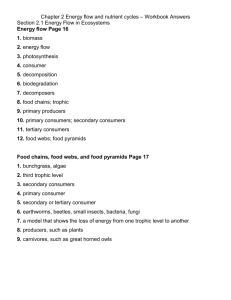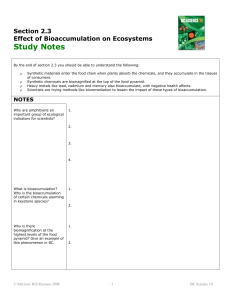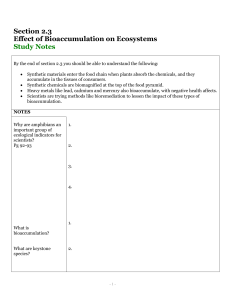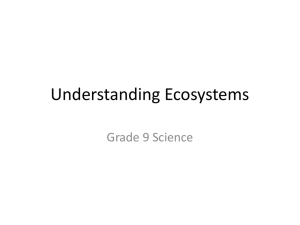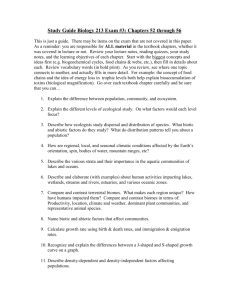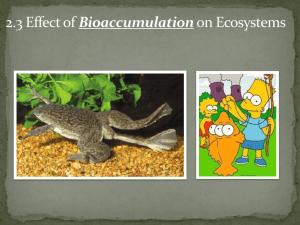Chapter 2 Energy flow and nutrient cycles – Workbook Answers
advertisement
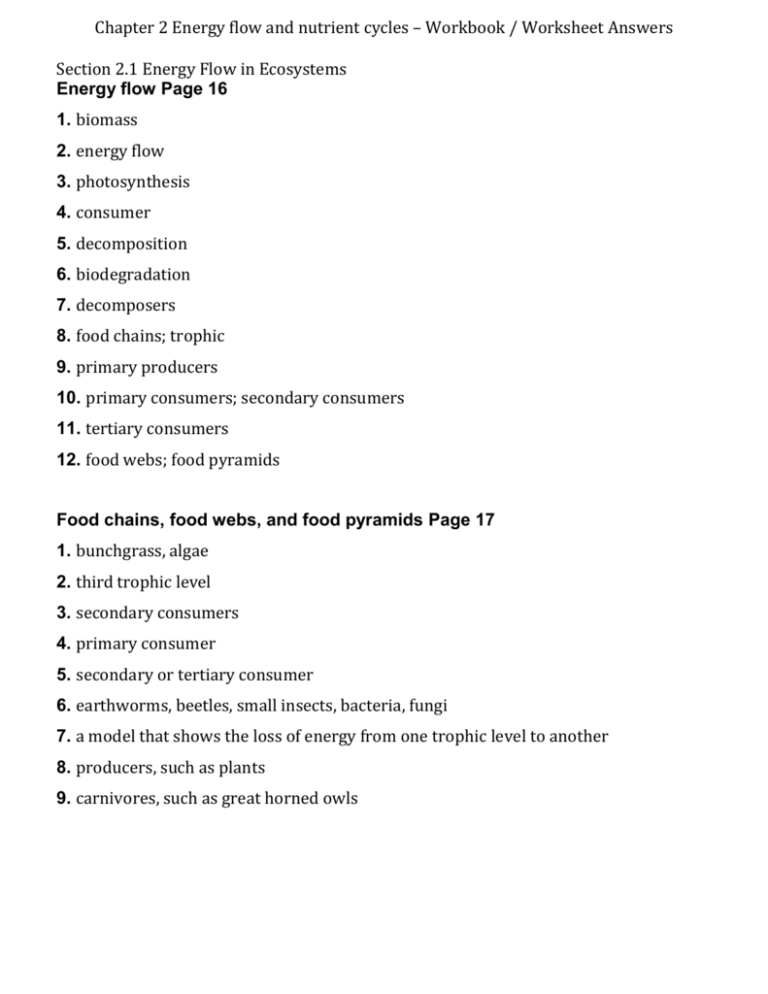
Chapter 2 Energy flow and nutrient cycles – Workbook / Worksheet Answers Section 2.1 Energy Flow in Ecosystems Energy flow Page 16 1. biomass 2. energy flow 3. photosynthesis 4. consumer 5. decomposition 6. biodegradation 7. decomposers 8. food chains; trophic 9. primary producers 10. primary consumers; secondary consumers 11. tertiary consumers 12. food webs; food pyramids Food chains, food webs, and food pyramids Page 17 1. bunchgrass, algae 2. third trophic level 3. secondary consumers 4. primary consumer 5. secondary or tertiary consumer 6. earthworms, beetles, small insects, bacteria, fungi 7. a model that shows the loss of energy from one trophic level to another 8. producers, such as plants 9. carnivores, such as great horned owls Energy flow in ecosystems Page 20 1. C 2. F 3. H 4. A 5. E 6. G 7. B 8. D 9. D 10. A 11. B 12. C 13. D 14. D Section 2.2 Nutrient Cycles in Ecosystems Nutrient cycles in ecosystems Page 29 1. F 2. A 3. E 4. B 5. D 6. G 7. C 8. B 9. A 10. D 11. C 12. B Section 2.3 Effects of Bioaccumulation on Ecosystems Bioaccumulation Page 33 1. bioaccumulation 2. keystone species 3. biomagnification 4. producers 5. PCBs 6. half-life 7. persistent organic pollutants 8. parts per million 9. heavy metals 10. lead; cadmium; mercury 11. bioremediation Impact of bioaccumulation on consumers Page 34 PCBs and the orca Page 36 1. PCBs are synthetic chemicals. Their full chemical name is polychlorinated biphenyl. 2. PCBs were used for industrial products, such as heat exchange fluids, paints, plastics, and lubricants for electrical transformers. 3. PCBs stay in the environment for a long time. Aquatic ecosystems and species that feed on aquatic organisms are especially sensitive to the effects of PCBs. PCBs bioaccumulate and biomagnify and also have a long half-life. 4. PCBs become concentrated in the orca’s blubber. 5. When salmon stocks are low, the orca’s blubber is burned for energy. The PCBs are released into the orca’s bloodstream and interfere with its immune system making it more susceptible to disease. 6. Diagram should be similar to Fig. 2.55 on page 95 of the student textbook. The pyramid should include the food chain for orcas and demonstrate the total PCB load that the orca is exposed to. Effects of bioaccumulation on ecosystems Page 37 1. F 2. D 3. E 4. B 5. C 6. A 7. C 8. D 9. B 10. C 11. A 12. D Effect of Bioaccumulation on ecosystems (p92-99) 1. a. amphibiens live in water and on land. b. In water, they are sensitive to the effects of chemical products and other pollutants in the environment. c. Their eggs are permeable and harmful chemical products can penetrate. d. Their skin makes them sensitive to toxic substances. 2. Key species effect the population and health of the entire ecosystem. 3. Certain products are stored in plant or animal tissues and remain trapped until they are either eaten or decomposed for energy. Consumers in each trophic level eat large quantities of the previous level. Concentrations build up. 4. a. aquatic orca ecosytem b.Number pyramid c. At the botton. Mud and water are contaminated. d. In microscopic plants and algae e. In the orca. f. BPC are stored in fat. g. The life of BPC is long. La durée de vie des BPC est longue. 5. Persistant Organic Pollutants, carbon containing compounds that remain in the water and soil for many many years. (insecticides like DDT) 6. DDT binds strongly to soil particles where they stay. They build up in plants that are then eaten by animals, and it is leached into water and contaminates aquatic environments. It can cause nervous system, immune and reproductive disorders. 7. Donne 2 exemples d’actions possibles pour réduire les effets de la pollution chimique. a. Adding phosphate fertilizers to trap contaminants in the soil. b. Bioremediation.
